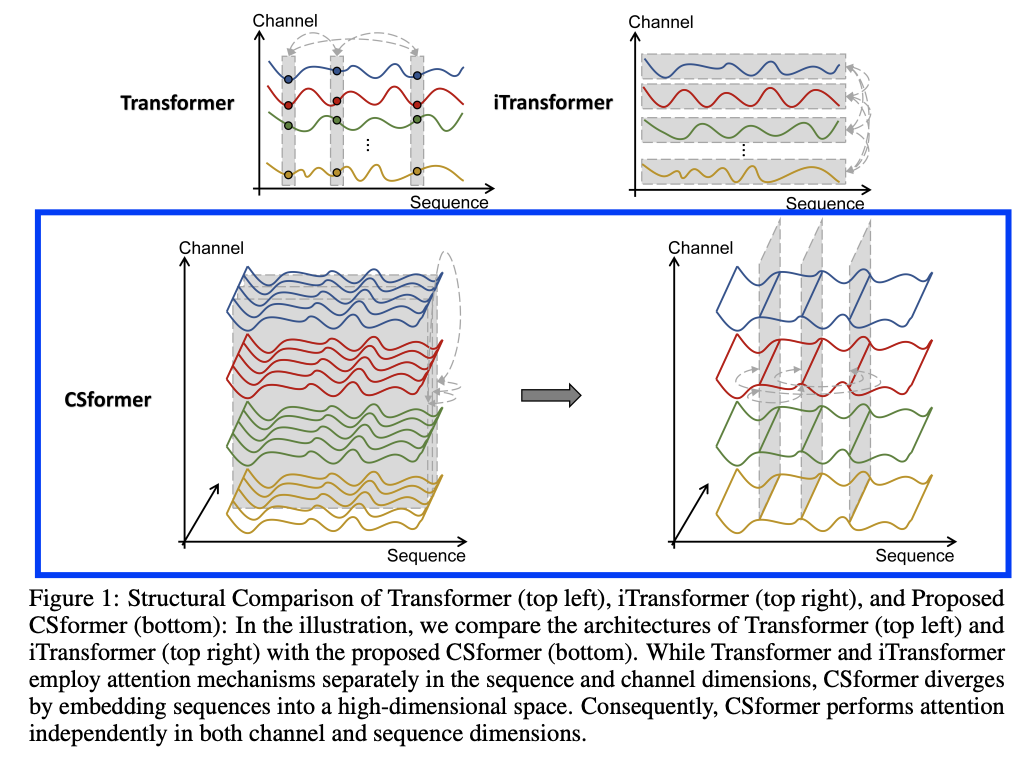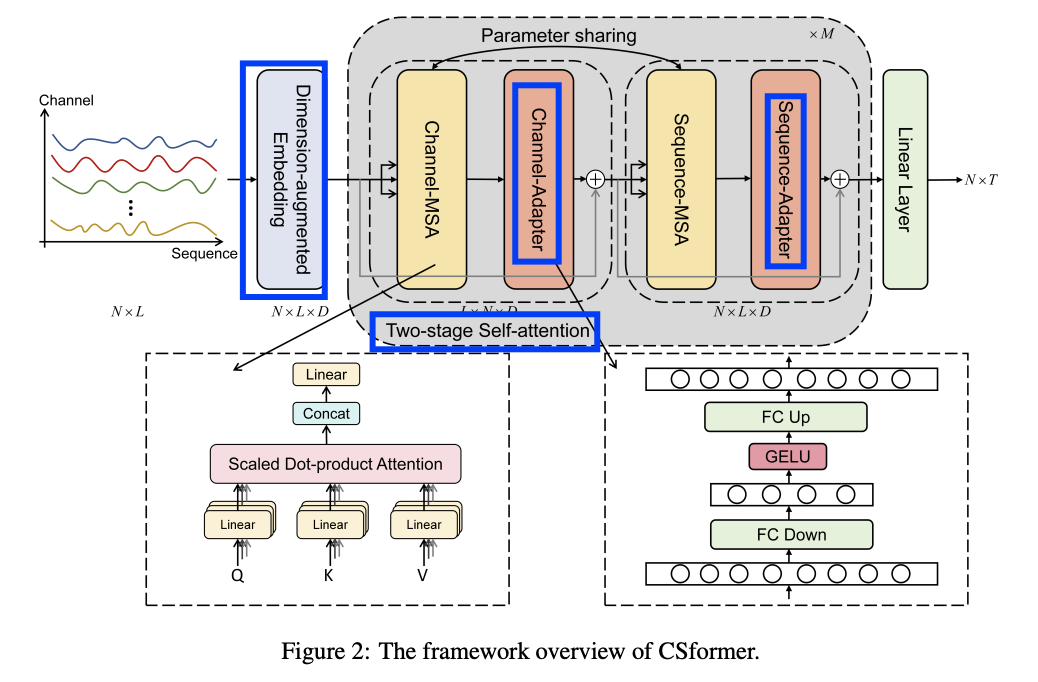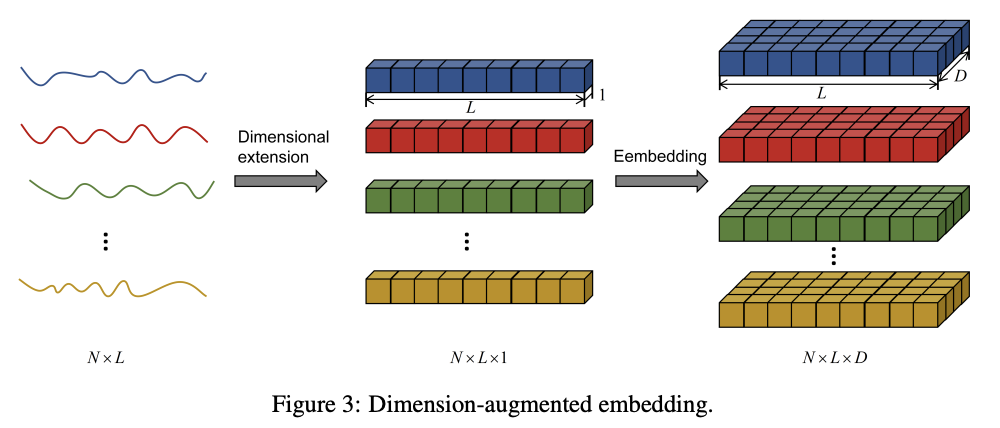Dance of Channel And Sequence: AN Efficient Attention-based Approach for MTS Forecasting
Contents
- Abstract
- Introduction
- Related Works
- CI Models
- CD Models
- CSFormer
- Preliminaries
- Dimension-augmented Embedding
- Two-stage MSA
- Prediction
0. Abstract
It is imperative to acknowledge the intricate interplay among channels
\(\rightarrow\) CI: impractical, leading to information degradation
CSformer
- Two-stage self-attention mechanism.
-
Enable the segregated extraction of
- (1) sequence-specific
- (2) channel-specific
information, while sharing parameters btw sequences and channels.
- Sequence adapters & Channel adapters
1. Introduction
[CI] PatchTST (Nie et al., 2023)
[CD] TSMixer (Ekambaram et al., 2023), Crossformer (Zhang & Yan, 2023)
- Fall short in capturing the mutual information between sequence and channel information
- Information distortion during data processing
CSformer
- Efficiently extracts and interplays sequence and channel information
- no change to attention in Transformer

- (1) Dimensionality-augmented embedding
- Elevates the dimensionality of sequences without compromising the integrity of the original information.
- (2) Shared attention mechanism
- along the sequence and channel dimensions
- share parameters, facilitating mutual influence
- (3) Adapter
- Sequence adapters
- Channel adapters
2. Related Works
(1) CI models
- DLinear
- PatchTST
(2) CD models
- Crossformer
- TSMixer
- iTransformer
PatchTST (Nie et al., 2023)
- extracting cross-dependency in an inappropriate manner would introduce noises
Motivation for CSformer
\(\rightarrow\) Find an effective way to leverage cross-variable information while adequately extract temporal information simultaneously.
3. CSFormer

Capable of concurrently learning channel and sequence information.
- Step 1) Dimension-augmented Embedding
- Step 2) Two-stage attention mechanism
- For channel & sequence
- Share parameters, facilitating interaction between channel and sequence information
- Step 3) Channel & Sequence adapters
- To ensure the distinct roles
(1) Preliminaries
Input TS: \(\mathbf{X}=\left\{\mathbf{x}_1, \ldots, \mathbf{x}_L\right\} \in \mathbb{R}^{N \times L}\),
- \(\mathbf{x}_i \in \mathbb{R}^N\) : variables at the \(i\)-th time point
- \(\mathbf{X}^{(k)} \in \mathbb{R}^L\) : sequence of the \(k\)-th variable
Prediction: \(\hat{\mathbf{X}}=\left\{\mathbf{x}_{L+1}, \ldots, \mathbf{x}_{L+T}\right\} \in \mathbb{R}^{N \times T}\).
Model: \(\mathbf{f}_\theta\)
MTS forecasting: \(\mathbf{f}_\theta(\mathbf{X}) \rightarrow \hat{\mathbf{X}}\).
(2) Dimension-augmented Embedding

Uplift Embedding
- \(\mathbf{X} \in \mathbb{R}^{N \times L} \rightarrow \mathbf{X} \in \mathbb{R}^{N \times L \times 1}\).
- \(\mathbf{H} \in \mathbb{R}^{N \times L \times D}=\mathbf{X} \times \nu\).
- Learnable vector \(\nu \in \mathbb{R}^{1 \times D}\),
(3) Two-stage MSA
Consisting of \(M\) blocks
- Each block = Two stage MSA.
Following the output of each MSA,
\(\rightarrow\) Adapter is appended !
Adapter
- Ensure discriminative learning of channel and sequence information
- Comprises two fully connected layers and an activation function layer
a) Channel MSA
Channel-wise attention at each time step to discern inter-channel dependencies
\(\mathbf{Z}_c=\operatorname{MSA}\left(\mathbf{H}_c\right)\),
- where \(\mathbf{H}_c \in \mathbb{R}^{L \times N \times D}\) , \(\mathbf{Z}_c \in \mathbb{R}^{L \times N \times D}\)
\(\mathbf{A}_c=\operatorname{Adapter}\left(\operatorname{Norm}\left(\mathbf{Z}_c\right)\right)+\mathbf{H}_c\).
- where \(\mathbf{A}_c \in \mathbb{R}^{L \times N \times D}\)
b) Sequence MSA
Reshape operation to seamlessly transition into \(\mathbf{H}_s\)
\(\mathbf{Z}_s=\operatorname{MSA}\left(\mathbf{H}_s\right)\).
- where \(\mathbf{H}_s \in \mathbb{R}^{N \times L \times D}\), \(\mathbf{Z}_s \in \mathbb{R}^{N \times L \times D}\)
\(\mathbf{A}_s=\operatorname{Adapter}\left(\operatorname{Norm}\left(\mathbf{Z}_s\right)\right)+\mathbf{H}_s\),
- where \(\mathbf{A}_s \in \mathbb{R}^{N \times L \times D}\)
(4) Prediction
Reshaping: resulting in \(\mathbf{Z} \in \mathbb{R}^{N \times(L * D)}\).
With linear layer: \(\hat{\mathbf{X}} \in \mathbb{R}^{N \times T}\).
